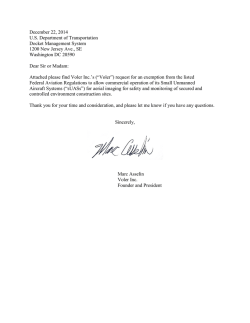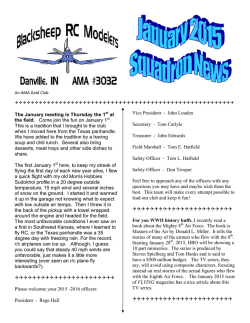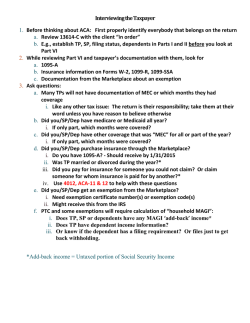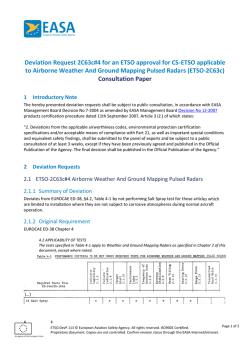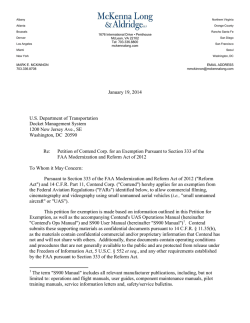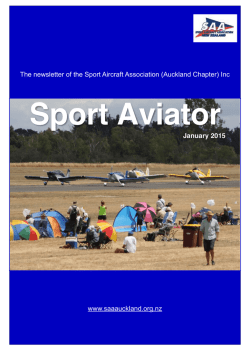
goFarm_LLC_-_Exemption_Rulemaking
January 30, 2015 U.S. Department of Transportation Docket Management System 1200 New Jersey Ave., SE Washington, DC 20590 Re: Exemption Request Under Section 333 of the FAA Reform Act and Part 11 of the Federal Aviation Regulations Dear Sir or Madam: Pursuant to Section 333 of the FAA Modernization and Reform Act of 2012 (the “Reform Act”) and 14 C.F.R. Part 11, goFarm LLC (“goFarm”), the operator of the goFarm GF-1 Unmanned Aircraft System (“UAS” or “GF-1”), seeks an exemption from the Federal Aviation Regulations (“FARs”) listed below and discussed in Appendix A. Attached as Appendix B is a summary of this request. The requested exemption would permit commercial operation of goFarm’s GF-1, which weighs less than 25 lbs. and performs precision aerial surveys that consist of still photographs taken by onboard cameras. The GF-1 takes a series of high quality, still digital images that are used to produce precision digital point clouds, triangulated models, and contour maps of the surveyed area. Applications for these UAS devices and associated data processing functions include agriculture, mining, and professional surveying. Use of the GF-1 for aerial surveys reduces the need to operate conventional aircraft for the same purpose and provides very high quality imagery at a fraction of the cost of surveys using conventional aircraft. These savings result in enhanced efficiency and productivity for the affected activities, as well as environmental benefits.1 Operations under the exemption will be subject to strict operating requirements and conditions to ensure at least an equivalent level of safety to currently authorized operations using manned aircraft and under conditions as may be modified by the FAA as required by Section 333. As described more fully below, the requested exemption would authorize commercial operations of aerial surveys using the GF-1, which at under 25 lbs. is small in size. The GF-1 will be operated under controlled conditions at low altitude in airspace that is limited in scope, as described more fully herein; 1 See, e.g. Jack Nicas, Drones Find Fans Among Farmers, Filmmakers, WALL STREET JOURNAL (March 10, 2014, 7:45 PM) (describing how an overseas surveyor used to spend 25,000 Euro ($34,345) to survey 15 square kilometers with a team of 12 surveyors, and it would take 2 to 3 weeks to collect all the data. With a Trimble UX5, he accomplished the same task for 5,000 Euro and got all the data he needed in 3 to 4 days. Because the surveys cost him less to perform, he passes those savings on to his customers.), available at: http://online.wsj.com/news/articles/SB10001424052702304732804579425342990070808. it will have automated control features, as described below. The GF-1 will be operated by an individual who has passed an FAA approved ground training exam and a training program for the UAS. Finally, the airspace in which the UAS will operate will be disclosed to the FAA in advance. goFarm respectfully submits that because this small, unmanned aerial vehicle—the GF-1—will be used in lieu of comparatively hazardous operations now conducted with fixed wing and rotary conventional aircraft, the FAA can have confidence that the operations will achieve at least an equivalent level or greater level of safety. Approval of this exemption would thereby enhance safety and fulfill the Secretary of Transportation’s (the FAA Administrator’s) responsibilities under Section 333(c) of the Reform Act to “establish requirements for the safe operation of such aircraft systems in the national airspace system.” The name and address of the applicant are: goFarm LLC Attn: Eric Silberg Ph: 240-602-9675 Email: [email protected] 7728 Ivymount Terrace Potomac, MD 20854 The regulations from which the exemption is requested are as follows: • 14 C.F.R. Part 21 • 14 C.F.R. 45.23(b) • 14 C.F.R. 61.113(a) & (b) • 14 C.F.R. 61.133(a) • 14 C.F.R. 91.7(b) • 14 C.F.R. 91.9(b)(2) • 14 C.F.R. 91.109(a) • 14 C.F.R. 91.119 • 14 C.F.R. 91.151(a) • 14 C.F.R. 91.203(a) & (b) • 14 C.F.R. 91.405(a) • 14 C.F.R. 91.407(a)(1) • 14 C.F.R. 91.409(a)(2) • 14 C.F.R. 91.417(a) Appendix A discusses each rule listed above and explains why exemptions pursuant to the proposal set forth in this letter are appropriate, provide an equivalent level of safety, and are in the public interest. THE APPLICABLE LEGAL STANDARD UNDER SECTION 333 goFarm submits that grant of this exemption application for use of the GF-1 in precision aerial surveys will advance the Congressional mandate in Section 333 of the Reform Act to accelerate the introduction of UASs into the national airspace system (“NAS”) if it can be accomplished safely. This law directs the Secretary of Transportation to consider whether certain UASs may operate safely in the NAS before completion of the rulemaking required under Section 332 of the Reform Act. In making this determination, the Secretary is required to determine which types of UASs do not create a hazard to users of the NAS or the public or pose a threat to national security in light of the following: • The UAS’s size, weight, speed, and operational capability; • Operation of the UAS in close proximity to airports and populated areas; and • Operation of the UAS within visual line of sight of the operator. Reform Act § 333(a)(1). If the Secretary determines that such vehicles “may operate safely in the national airspace system, the Secretary shall establish requirements for the safe operation of such aircraft in the national airspace system.” Id. §333(c).2 The Federal Aviation Act expressly grants the FAA the authority to issue exemptions. This statutory authority, by its terms, includes exempting civil aircraft, as the term is defined under §40101 of the Act, from the requirement that all civil aircraft must have a current airworthiness certificate and those regulations requiring commercial pilots to operate aircraft in commercial service: The Administrator may grant an exemption from a requirement of a regulation prescribed under subsection (a) or (b) of this section or any of sections 44702-44716 of this title if the Administrator finds the exemption is in the public interest. 49 U.S.C. §44701(f). See also 49 USC §44711(a); 49 USC §44704; 14 CFR §91.203(a)(1). The grant of the requested exemption is in the public interest based on the clear direction in Section 333 of the Reform Act; the additional authority in the Federal Aviation Act, as amended; the strong equivalent level of safety surrounding the proposed operations; and the significant public benefit, including enhanced safety and cost savings associated with transitioning to UASs for aerial survey photography. Accordingly, the applicant respectfully requests that the FAA grant the requested exemption without delay. Airworthiness of the GF-1 A critical element of the exemption application involves evidence of the airworthiness of the GF-1. goFarm believes that it is in compliance with the requirements of Order 8130.34C, Airworthiness 2 Applicant submits that this provision places a duty on the Administrator to not only process applications for exemptions under Section 333, but for the Administrator, if he deems the conditions proposed herein require modification in order to allow approval, to supply conditions for the safe operation of the UAS. goFarm welcomes the opportunity to consult with FAA staff in order to address any issues or concerns that this proposal may raise that they believe may require modification. Certification of Unmanned Aircraft Systems and Optionally Piloted Aircraft, in its use of systems developed by DJI for the design and construction of the GF-1.3 Based on the proven S1000+ octocopter and A2 flight control system, the GF-1 has a high degree of redundancy and numerous safety features, including: • Power system redundancy permitting the loss of any motor without losing control of the vehicle • Return-to-home failsafe in the event of a loss of communications • Configurable limitations for area of operation and altitude • Configurable limitations for vertical and horizontal speed Additional safety features added by goFarm in construction of the GF-1 UAS include: • High visibility lighting system • Redundant primary power system • Redundant voltage telemetry for power system The criteria set forth in the Order specify the substantive showings of the device’s safety and fitness for operation to ensure that the FAA has sufficient basis to evaluate the aircraft’s safety. Mandatory Operating Conditions Grant of the exemption to goFarm will be subject to the following mandatory conditions, which are based upon operating conditions set forth for operation of UAS by public entities pursuant to Certificates of Authorization, with additional restrictions: • All operations to occur in Class G airspace. • Operations to avoid congested or populated areas, which are depicted in yellow on VFR charts. • Operations to be conducted over private or controlled-access property. • Permission from land owner/controller required before commencing any flight. • Operations to occur during Visual Flight Rules Meteorological Conditions (VMC). • Aircraft to remain within Visual Line of Sight (VLOS). o VLOS guaranteed with a cylinder of operation around operator of 1⁄2 nautical miles (NM). o Cylinder walls may be expanded by observer with ability to control aircraft. • Operations to occur during daylight hours. • Above Ground Level (AGL) altitude to be restricted to 400 feet. • All operations conducted in vicinity of airport to remain more than 2.5 NM from centerline azimuth of runway centerline measured from runway thresholds. • Operator will file a NOTAM for each flight, as required. • All required permissions and permits will be obtained from territorial, state, county or city jurisdictions, including local law enforcement, fire, or other appropriate governmental agencies. 3 goFarm is submitting the following documents in support of this exemption application for the GF-‐1: 1) GF-‐1 Preflight Checklist (Exhibit 1); 2) DJI S1000+ Operations and Maintenance Manual (Exhibit 2); and 3) DJI A2 Operations and Maintenance Manual (Exhibit 3). Operator Requirements goFarm respectfully proposes that operator requirements should take into account the characteristics of the particular UAS. Certain UASs, such as the goFarm GF-1, are characterized by a high degree of preprogrammed control and various built-in technical capabilities that limit the potential for operation outside of the operating conditions set forth above. The GF-1 has a semi-autonomous navigation and control system comprised of a Ground Control Station (GCS) and auto-pilot system. All flights are pre-programmed with GPS guidance and do not require human intervention. Flight mission area and routing cannot be changed after launch. Flights are not directed by positive manual control, nor are evasive maneuvers. In the case of unplanned events, the operator inputs pre-programmed evasive maneuvers from the control unit and the control unit executes that maneuver. Pre-programmed operator interventions include diversion to the right; initiation of holding at present position; suspension of mission; fly back to launch point; fly to point and hold; abort mission and land; and emergency power cut off and land (Flight Termination System).7 Additional automated safety functions and safety enhancing features of the GF-1 include the following: • Auto-pilot detection of lost GPS or of insufficient satellites initiates an immediate vertical landing, unless overridden by pilot in command. • Low power on the aircraft triggers escalating alarms at GCS at 35% and 10% levels. • If the auto-pilot detects a lost-link to the GCS for longer than 30 seconds, return-to-home sequence initiates. • The GF-1 is inherently unstable, so auto-pilot fail will result in very rapid exit from flight. • Aircraft has an on-board failsafe that limits speed in the event of dive to approximately 14 m/s. • The aircraft, weighing less than 25 lbs., fully loaded, is constructed of composite material intended to absorb impact energy. • The motors are driven by pulse width modulated signals, not analog signals. Given these safety features, goFarm proposes that operators of the GF-1 should not be required to hold a commercial or private pilot certification. Instead, operators should be required to: • have successfully completed, at a minimum, FAA private pilot ground instruction and passed the FAA Private Pilot written examination or FAA-recognized equivalents; • have successfully demonstrated capability to operate UAS in accordance with manufacturer standards. goFarm notes that the FAA has found that safety factors permitted operation of UASs by operators with these qualifications in the case of operations pursuant to public COAs when the mandatory operating conditions specified above were present. See Federal Aviation Administration, Notice N-8900.227, Unmanned Aircraft Systems (UAS) Operational Approval, at 20-21 (July 30, 2013). The FAA has the statutory authority to grant exemptions to the requirements for and privileges associated with the grant of airmen’s certificates. 49 USC §44701 (f). In summary, applicant seeks an exemption from the FARs set forth above and in Appendix A to allow commercial operations of a small unmanned vehicle conducting precision aerial surveys. Approval of the exemption allowing commercial operations of the GF-1 for precision survey work will enhance safety by reducing risk. Conventional aerial survey operations, using jet or piston-powered aircraft present risks associated with vehicles that weigh in the neighborhood of 5,000 to 7,000 lbs., or more, carry large quantities of fuel, passengers, and, in some cases, cargo. Such aircraft must fly to and from the survey location. In contrast, a GF-1 weighing less than 25 lbs. and powered by batteries eliminates a portion of that risk given the reduced mass and lack of combustible fuel carried on board. The GF-1 is carried to the survey location, not flown there. The GF-1 will carry no passengers or crew and, therefore, will not expose any individuals to the risks associated with manned aircraft flights. Additionally, no national security issue is raised by the grant of the requested exemptions. Given the size, load carrying capacity, speed at which it operates, and the fact that it carries no explosives or other dangerous materials, the GF-1 poses no threat to national security. The operation of the GF-1, weighing less than 25 lbs., for precision surveys in accordance with the strict conditions outlined above, will provide an equivalent level of safety supporting the grant of the exemptions requested herein, including exempting goFarm from the requirements of Part 21. The GF-1’s satisfaction of the criteria set forth in Section 333 of the Reform Act—size, weight, speed, operating capabilities, lack of proximity to airports and populated areas, operation within visual line of sight, and national security—and its showing of an equivalent level of safety as it may relate to the requirement for a pilot’s license, provide more than adequate justification for the grant of the requested exemptions allowing commercial operation of the GF-1 in the commercial precision aerial survey business. Very Respectfully, Eric Silberg CTO, goFarm LLC APPENDIX A EXEMPTION REQUEST AND EQUIVALENT LEVEL OF SAFETY SHOWINGS UNDER APPLICABLE RULES SUBJECT TO EXEMPTION goFarm requests an exemption from the following regulations as well as any additional regulations that may technically apply to the operation of the GF-1: 14 C.F.R. § 45.23(b): Marking of the Aircraft The regulation provides: When marks include only the Roman capital letter “N” and the registration number is displayed on limited, restricted or light-sport category aircraft or experimental or provisionally certificated aircraft, the operator must also display on that aircraft near each entrance to the cabin, cockpit, or pilot station, in letters not less than 2 inches nor more than 6 inches high, the words “limited,” “restricted,” “light-sport,” “experimental,” or “provisional,” as applicable. The GF-1 has no entrance to the cabin, cockpit, or pilot station on which the word “Experimental” can be placed. Given the size of the UAV, two-inch lettering will be impossible. The word “Experimental” will be placed on the forward fuselage in compliance with § 45.29(f). The equivalent level of safety will be achieved by having the GF-1 marked as required by § 45.29(f) where the pilot, observer, and others working with the UAV will see the identification of the UAS as “Experimental.” The FAA has issued the following exemptions to this regulation, Exemption Nos. 10700, 8738, 10167 and 10167A. 14 C.F.R. Part 21, Subpart H: Airworthiness Certificates 14 CFR § 91.203(a)(1) Section 91.203(a)(1) requires all civil aircraft to have a certificate of airworthiness. Part 21, Subpart H, entitled Airworthiness Certificates, establishes the procedural requirements for the issuance of airworthiness certificates as required by FAR § 91.203(a)(1). Given the size of the aircraft (under 25lbs.) and the limited operating area associated with its utilization, it is unnecessary to go through the certificate of airworthiness process under Part 21 Subpart H to achieve or exceed current safety levels. Such an exemption meets the requirements of an equivalent level of safety under Part 11 and Section 333 of the Reform Act. The Federal Aviation Act and Section 333 of the Reform Act both authorize the FAA to exempt aircraft from the requirement for an airworthiness certificate, upon consideration of the size, weight, speed, operational capability, and proximity to airports and populated areas of the UAS involved. In this case, an analysis of these criteria demonstrates that the GF-1 operated without an airworthiness certificate, under the conditions proposed herein, will be at least as safe, or safer, than a conventional aircraft (fixed wing or rotorcraft) with an airworthiness certificate. The GF-1 weighs less than 25 lbs. fully loaded. It will not carry a pilot or passenger, will not carry flammable fuel, and will operate exclusively within an area pre-disclosed and in compliance with conditions set forth herein. Operations under this exemption will be tightly controlled and monitored by both the operator, pursuant to the conditions set forth above, and by local public safety requirements. The FAA will have advance notice of all operations through the filing of NOTAMs. Receipt of the prior permission of the land owner, the size of the aircraft, the lack of flammable fuel, and the fact that the aircraft is carried to the location and not flown there all establish the equivalent level of safety. The GF-1 construction with absorbent material provides at least an equivalent level of safety to that of such operations being conducted with conventional aircraft that would be orders-of-magnitude larger and would be carrying passengers, cargo, and flammable fuel. 14 C.F.R. § 61.113(a) & (b); 61.133(a): Private Pilot Privileges and Limitations; Pilot in Command; Commercial Pilot Privileges and Limitations. Section 61.113(a) & (b) limit private pilots to non-commercial operations. Unlike a conventional aircraft that carries a pilot, passengers, and cargo, the GF-1 in this case is remotely controlled with no passengers or property of others on board. Section 61.133(a) requires an individual with a commercial pilot’s license to be pilot in command of an aircraft for compensation or hire. goFarm respectfully proposes that operator requirements should take into account the characteristics of the particular UAS. goFarm’s GF-1 has a high degree of pre-programmed control and various built-in technical capabilities that strictly limit the potential for operation outside of the operating conditions set forth in the exemption application. The GF-1 has a semi-autonomous navigation and control system comprised of a Ground Control Station (GCS) and auto-pilot system. All flights are pre-programmed with precision GPS guidance and do not require human intervention. Flight mission area and routing cannot be changed after launch. Flights are not directed by positive manual control, nor are evasive maneuvers. In the case of unplanned events, the operator inputs pre-programmed evasive maneuvers from the control unit, and the control unit executes that maneuver. Pre-programmed operator interventions include diversion to the right; initiation of holding at present position; suspension of mission; fly back to launch point; fly to point and hold; abort mission and land; and emergency power cut off and land (Flight Termination System). Additional automated safety functions and safety enhancing features of the GF-1 include the following: • Auto-pilot detection of lost GPS or of insufficient satellites initiates an immediate spiral landing. • Low power on the aircraft triggers escalating alarms at GCS at 35% and 10% levels. • If the auto-pilot detects a lost-link to the GCS for longer than 30 seconds, landing procedure begins. • The GF-1 is inherently unstable, so auto-pilot fail will result in very rapid exit from flight. • Aircraft has an on-board failsafe that limits speed in the event of dive to approximately 14 m/s. • The aircraft, weighing less than 25 lbs., fully loaded, is constructed of composite material which is intended to absorb impact energy. • The motors are driven by pulse width modulated signals, not analog signals. Given these safety features, goFarm proposes that operators of the GF-1 should not be required to hold a commercial or private pilot certification. Instead, operators should be required to: • have successfully completed, at a minimum, FAA private pilot ground instruction and passed the FAA Private Pilot written examination or FAA-recognized equivalents; • have completed the manufacturer’s training program for operation of the UAS. The manufacturer’s training program will have been satisfactorily reviewed through the SAC process. goFarm notes that the FAA has found that safety factors permitted operation of UASs by operators with these qualifications in the case of operations pursuant to public COAs where the mandatory operating conditions specified above are present. See Federal Aviation Administration, Notice N-8900.227, Unmanned Aircraft Systems (UAS) Operational Approval, at 20-21 (July 30, 2013). The FAA has the statutory authority, granted at 49 U.S.C.§44701(f) to waive the pilot requirements for commercial operations. Given these conditions and restrictions, an equivalent level of safety will be provided by allowing operation of the GF-1 without a private pilot’s certificate or a commercial pilot’s certificate, under the conditions set forth herein. The risks associated with the operation of the GF-1 (given its size, speed, operational capabilities, and lack of combustible fuel) are so diminished from the level of risk associated with private pilot operations or commercial operations contemplated by Part 61 with conventional aircraft (fixed wing or rotorcraft), that allowing operations of the UAS as set forth above meets or exceeds the present level of safety provided under 14 C.F.R. § 61.113(a) & (b) and does not rise to the level of requiring a commercial pilot to operate the aircraft under § 61.133(a). 14 C.F.R. § 91.7(a): Civil aircraft airworthiness. This regulation requires that no person may operate a civil aircraft unless it is in airworthy condition. Should the exemption be granted allowing commercial operation of the GF-1 without an airworthiness certificate, no standard will exist for airworthiness of the GF-1. Given the size of the aircraft and the requirements that have presumably already been met in the SAC approval process for the GF-1 (for instance, the GF-1’s Maintenance & Inspection Manual and Safety Checklist), an equivalent level of safety will be achieved by insuring compliance with the goFarm manuals prior to each flight. 14 C.F.R. § 91.9(b)(2): Civil Aircraft Flight Manual in the Aircraft. The regulation provides: No person may operate a U.S.-registered civil aircraft ... (2)…For which an Airplane or Rotorcraft Flight Manual is not required by §21.5 of this chapter, unless there is available in the aircraft a current approved airplane or Rotorcraft Flight Manual, approved manual material, markings, and placards, or any combination thereof. Given the size and configuration of the GF-1, it has no ability or place to carry such a flight manual on the aircraft, not only because there is no pilot on board, but because there is no room or capacity to carry such an item on the aircraft. The equivalent level of safety will be achieved by keeping the flight manual (see, e.g., User Guide, Exhibit 2) at the ground control point where the pilot flying the UAS will have immediate access to it. The FAA has issued the following exemptions to this regulation: Exemption Nos. 8607, 8737, 8738, 9299, 9299A, 9565, 9565B, 10167, 10167A, 10602, 32827, and 10700. 14 C.F.R. § 91.109(a) & 91.319(a)(1): Flight Instruction These regulations provide that no person may operate a civil aircraft (except a manned free balloon) that is being used for flight instruction unless that aircraft has fully functioning dual controls. The GF-1 is a remotely piloted aircraft and by design, does not have fully functional dual controls. Flight control is accomplished through the use of a control box that communicates with the aircraft via radio communications. The flight plan is pre-programmed into the auto pilot before flight and only in unusual circumstances will the pilot input control functions to alter the pre-programmed flight. If instruction is accomplished through a training program, as set forth in Exhibit 2, an equivalent level of safety will be assured. The FAA has approved exemptions for flight training without fully functional dual controls for a number of aircraft and for flight instruction in experimental aircraft. See Exemption Nos. 5778K & 9862A. The equivalent level of safety will be achieved by the manufacturer providing the training as outlined, for example, in Exhibit 2 and through the use of experienced and qualified pilots familiar with the GF-1. 14 CFR § 91.119: Minimum Safe Altitudes Section 91.119 establishes safe altitudes for operation of civil aircraft. Specifically, 91.119(c) limits aircraft flying over areas other than congested areas to an altitude of 500 feet above the surface, except over open water or sparsely populated areas. In those cases, the aircraft may not be operated closer than 500 feet to any person, vessel, vehicle, or structure. As set forth herein, the GF-1 will never operate at higher than 400 feet AGL. It will, however, be operated to avoid congested or populated areas that are depicted in yellow on VFR sectional charts. Because aerial survey work must be accomplished at relatively low altitudes and at altitudes less than 500 feet AGL, an exemption from Section 91.119(c) is needed. The equivalent level of safety will be achieved given the size, weight, speed, and material with which the GF-1 is built. Also, no flight will be taken without the permission of the land owner or those who control the land. Because of the advance notice to the landowner, all affected individuals will be aware of the survey flights. Compared to aerial survey operations conducted with aircraft or rotorcraft weighing far more than 25 lbs. and carrying flammable fuel, any risk associated with these operations will be far less than those currently allowed with conventional aircraft operating at or below 500 feet AGL. Indeed, the low-altitude operations of the UAS will maintain separation between these smallUAS operations and the operations of conventional aircraft that must comply with Section 91.119. 14 C.F.R. § 91.151(a): Fuel Requirements for Flight in VFR Conditions This regulation prohibits an individual from beginning “a flight in an airplane under VFR conditions unless (considering wind and forecast weather conditions) there is enough fuel to fly to the first point of intended landing and, assuming normal cruising speed – (1) During the day, to fly after that for at least 30 minutes; or (2) At night, to fly after that for at least 45 minutes.” The GF-1 batteries provide approximately 50 minutes of powered flight. Without an exemption from § 14 CFR 91.151, the UAS’s flights would be limited to approximately 20 minutes in length. Given the limitations on its proposed operations and the location of those proposed operations, a longer time frame for flight in daylight VFR conditions is reasonable. goFarm believes that an exemption from 14 CFR § 91.151(a) is safe and within the scope of a prior exemption. See Exemption 10673 (allowing Lockheed Martin Corporation to operate without compliance with 91.151(a)). Operating the small UAS, without 30 minutes of reserve fuel does not engender the type of risks that Section 91.151(a) was meant to prevent given the size and speed at which the UAS operates. The fact that it carries no pilot, passenger, or cargo also enhances its safety. Additionally, limiting GF-1 flights to 20 minutes would greatly reduce their utility. In the unlikely event that the GF-1 should run out of fuel, it would simply land. Given its weight and construction material, the risks are less than contemplated by the current regulation. goFarm believes that an equivalent level of safety can be achieved by maintaining 10 minutes of reserve fuel, which, allowing 40 minutes of flight time, would be more than adequate to return the UAS to its planned landing zone from anywhere in its operating area. 14 C.F.R. § 91.203 (a) & (b): Carrying Civil Aircraft Certification and Registration This regulation provides as follows: (a)...no person may operate a civil aircraft unless it has...an appropriate and current airworthiness certificate. (b) No person may operate a civil aircraft unless the airworthiness certificate required by paragraph (a) of this section or a special flight authorization issued under §91.715 is displayed at the cabin or cockpit entrance so that it is legible to passengers or crew. The GF-1 fully loaded weighs no more than 25 lbs. As such, there is no ability or place to carry certification and registration documents or to display them on the UAS. In addition, there is no pilot on board the aircraft. An equivalent level of safety will be achieved by keeping these documents at the ground control point where the pilot flying the UAS will have immediate access to them. The FAA has issued numerous exemptions to this regulation. A representative sample of other exceptions includes Exemption Nos. 9565, 9665, 9789, 9789A, 9797, 9797A, 9816A, and 10700. 14 C.F.R. § 91.405(a); 407(a)(1); 409(a)(2); 417(a): Maintenance Inspections Section 91.405(a) requires that an aircraft operator or owner “shall have that aircraft inspected as prescribed in subpart E of this part and shall between required inspections, except as provided in paragraph (c) of this section, have discrepancies repaired as prescribed in part 43 of this chapter...” Section 91.407 similarly makes reference to requirements in Part 43; Section 91.409(a)(2) requires an annual inspection for the issuance of an air worthiness certificate. Section 91.417(a) requires the owner or operator to keep records showing certain maintenance work that has been accomplished by certificated mechanics, under Part 43, or licensed pilots and records of approval of the aircraft for return to service. Maintenance of the GF-1 will be accomplished by the owner/operator pursuant to the manuals, such as Exhibit 3, provided by goFarm. An equivalent level of safety will be achieved because the UAS is small in size, will operate only in restricted predetermined areas, and is not a complex mechanical device. As provided in the attached User Manual and the Safety Checklist, the operator of GF-1 will ensure that the UAS is in working order prior to initiating flight, perform required maintenance, and keep a log of any maintenance that is performed. Moreover, the operator is the person most familiar with the aircraft and is best suited to maintain the aircraft in an airworthy condition and to ensure an equivalent level of safety. APPENDIX B SUMMARY OF GOFARM SECTION 333 EXEMPTION REQUEST goFarm hereby provides pursuant to Part 11 a summary of its exemption application to allow commercial operation of the GF-1 unmanned aircraft in precision aerial survey work. An exemption is requested from the following regulations: • 14 C.F.R. Part 21 • 14 C.F.R. 45.23(b) • 14 C.F.R. 61.113(a) & (b) • 14 C.F.R. 61.133(a) • 14 C.F.R. 91.7(b) • 14 C.F.R. 91.9(b)(2) • 14 C.F.R. 91.109(a) • 14 C.F.R. 91.119 • 14 C.F.R. 91.151(a) • 14 C.F.R. 91.203(a) & (b) • 14 C.F.R. 91.405(a) • 14 C.F.R. 91.407(a)(1) • 14 C.F.R. 91.409(a)(2) • 14 C.F.R. 91.417(a)
© Copyright 2025
